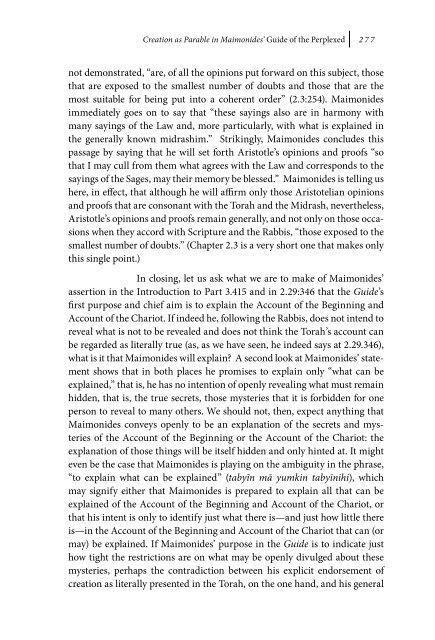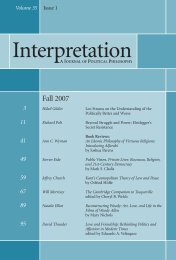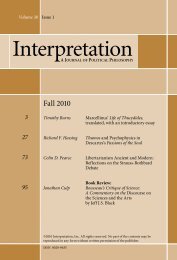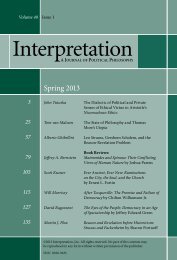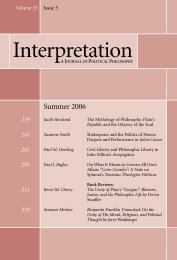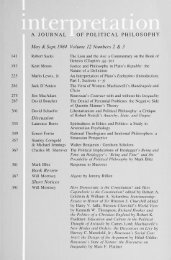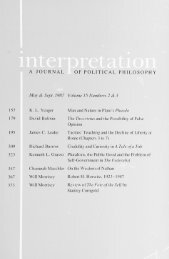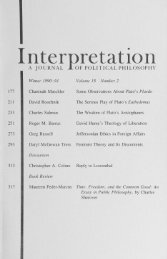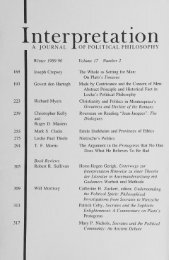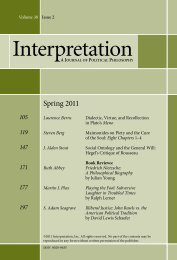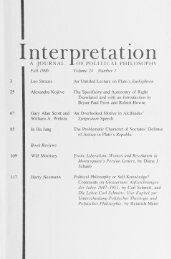Spring 2010 - Interpretation
Spring 2010 - Interpretation
Spring 2010 - Interpretation
Create successful ePaper yourself
Turn your PDF publications into a flip-book with our unique Google optimized e-Paper software.
Creation as Parable in Maimonides’ Guide of the Perplexed<br />
2 7 7<br />
not demonstrated, “are, of all the opinions put forward on this subject, those<br />
that are exposed to the smallest number of doubts and those that are the<br />
most suitable for being put into a coherent order” (2.3:254). Maimonides<br />
immediately goes on to say that “these sayings also are in harmony with<br />
many sayings of the Law and, more particularly, with what is explained in<br />
the generally known midrashim.” Strikingly, Maimonides concludes this<br />
passage by saying that he will set forth Aristotle’s opinions and proofs “so<br />
that I may cull from them what agrees with the Law and corresponds to the<br />
sayings of the Sages, may their memory be blessed.” Maimonides is telling us<br />
here, in effect, that although he will affirm only those Aristotelian opinions<br />
and proofs that are consonant with the Torah and the Midrash, nevertheless,<br />
Aristotle’s opinions and proofs remain generally, and not only on those occasions<br />
when they accord with Scripture and the Rabbis, “those exposed to the<br />
smallest number of doubts.” (Chapter 2.3 is a very short one that makes only<br />
this single point.)<br />
In closing, let us ask what we are to make of Maimonides’<br />
assertion in the Introduction to Part 3.415 and in 2.29:346 that the Guide’s<br />
first purpose and chief aim is to explain the Account of the Beginning and<br />
Account of the Chariot. If indeed he, following the Rabbis, does not intend to<br />
reveal what is not to be revealed and does not think the Torah’s account can<br />
be regarded as literally true (as, as we have seen, he indeed says at 2.29.346),<br />
what is it that Maimonides will explain? A second look at Maimonides’ statement<br />
shows that in both places he promises to explain only “what can be<br />
explained,” that is, he has no intention of openly revealing what must remain<br />
hidden, that is, the true secrets, those mysteries that it is forbidden for one<br />
person to reveal to many others. We should not, then, expect anything that<br />
Maimonides conveys openly to be an explanation of the secrets and mysteries<br />
of the Account of the Beginning or the Account of the Chariot: the<br />
explanation of those things will be itself hidden and only hinted at. It might<br />
even be the case that Maimonides is playing on the ambiguity in the phrase,<br />
“to explain what can be explained” (tabyīn mā yumkin tabyīnihi), which<br />
may signify either that Maimonides is prepared to explain all that can be<br />
explained of the Account of the Beginning and Account of the Chariot, or<br />
that his intent is only to identify just what there is—and just how little there<br />
is—in the Account of the Beginning and Account of the Chariot that can (or<br />
may) be explained. If Maimonides’ purpose in the Guide is to indicate just<br />
how tight the restrictions are on what may be openly divulged about these<br />
mysteries, perhaps the contradiction between his explicit endorsement of<br />
creation as literally presented in the Torah, on the one hand, and his general


